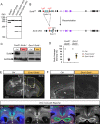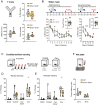Early loss of Scribble affects cortical development, interhemispheric connectivity and psychomotor activity
- PMID: 33907211
- PMCID: PMC8079449
- DOI: 10.1038/s41598-021-88147-1
Early loss of Scribble affects cortical development, interhemispheric connectivity and psychomotor activity
Abstract
Neurodevelopmental disorders arise from combined defects in processes including cell proliferation, differentiation, migration and commissure formation. The evolutionarily conserved tumor-suppressor protein Scribble (Scrib) serves as a nexus to transduce signals for the establishment of apicobasal and planar cell polarity during these processes. Human SCRIB gene mutations are associated with neural tube defects and this gene is located in the minimal critical region deleted in the rare Verheij syndrome. In this study, we generated brain-specific conditional cKO mouse mutants and assessed the impact of the Scrib deletion on brain morphogenesis and behavior. We showed that embryonic deletion of Scrib in the telencephalon leads to cortical thickness reduction (microcephaly) and partial corpus callosum and hippocampal commissure agenesis. We correlated these phenotypes with a disruption in various developmental mechanisms of corticogenesis including neurogenesis, neuronal migration and axonal connectivity. Finally, we show that Scrib cKO mice have psychomotor deficits such as locomotor activity impairment and memory alterations. Altogether, our results show that Scrib is essential for early brain development due to its role in several developmental cellular mechanisms that could underlie some of the deficits observed in complex neurodevelopmental pathologies.
Conflict of interest statement
The authors declare no competing interests.
Figures








Similar articles
-
Neuron-Specific Deletion of Scrib in Mice Leads to Neuroanatomical and Locomotor Deficits.Front Genet. 2022 May 25;13:872700. doi: 10.3389/fgene.2022.872700. eCollection 2022. Front Genet. 2022. PMID: 35692812 Free PMC article.
-
The embryonic development of hindbrain respiratory networks is unaffected by mutation of the planar polarity protein Scribble.Neuroscience. 2017 Aug 15;357:160-171. doi: 10.1016/j.neuroscience.2017.05.046. Epub 2017 Jun 3. Neuroscience. 2017. PMID: 28583412
-
The planar polarity protein Scribble1 is essential for neuronal plasticity and brain function.J Neurosci. 2010 Jul 21;30(29):9738-52. doi: 10.1523/JNEUROSCI.6007-09.2010. J Neurosci. 2010. PMID: 20660256 Free PMC article.
-
The polarity protein Scrib mediates epidermal development and exerts a tumor suppressive function during skin carcinogenesis.Mol Cancer. 2015 Sep 17;14:169. doi: 10.1186/s12943-015-0440-z. Mol Cancer. 2015. PMID: 26376988 Free PMC article.
-
Scribble modulates the MAPK/Fra1 pathway to disrupt luminal and ductal integrity and suppress tumour formation in the mammary gland.PLoS Genet. 2014 May 22;10(5):e1004323. doi: 10.1371/journal.pgen.1004323. eCollection 2014 May. PLoS Genet. 2014. PMID: 24852022 Free PMC article.
Cited by
-
Small protein plays with big networks.Trends Genet. 2024 Jan;40(1):17-19. doi: 10.1016/j.tig.2023.10.008. Epub 2023 Oct 24. Trends Genet. 2024. PMID: 37879968 Free PMC article.
-
Neuron-Specific Deletion of Scrib in Mice Leads to Neuroanatomical and Locomotor Deficits.Front Genet. 2022 May 25;13:872700. doi: 10.3389/fgene.2022.872700. eCollection 2022. Front Genet. 2022. PMID: 35692812 Free PMC article.
-
WNT signaling at the intersection between neurogenesis and brain tumorigenesis.Front Mol Neurosci. 2022 Oct 4;15:1017568. doi: 10.3389/fnmol.2022.1017568. eCollection 2022. Front Mol Neurosci. 2022. PMID: 36267699 Free PMC article. Review.
-
Roles of Rac1-Dependent Intrinsic Forgetting in Memory-Related Brain Disorders: Demon or Angel.Int J Mol Sci. 2023 Jun 27;24(13):10736. doi: 10.3390/ijms241310736. Int J Mol Sci. 2023. PMID: 37445914 Free PMC article. Review.
-
Immunoproximity biotinylation reveals the axon initial segment proteome.Nat Commun. 2023 Dec 11;14(1):8201. doi: 10.1038/s41467-023-44015-2. Nat Commun. 2023. PMID: 38081810 Free PMC article.
References
Publication types
MeSH terms
Substances
LinkOut - more resources
Full Text Sources
Molecular Biology Databases

